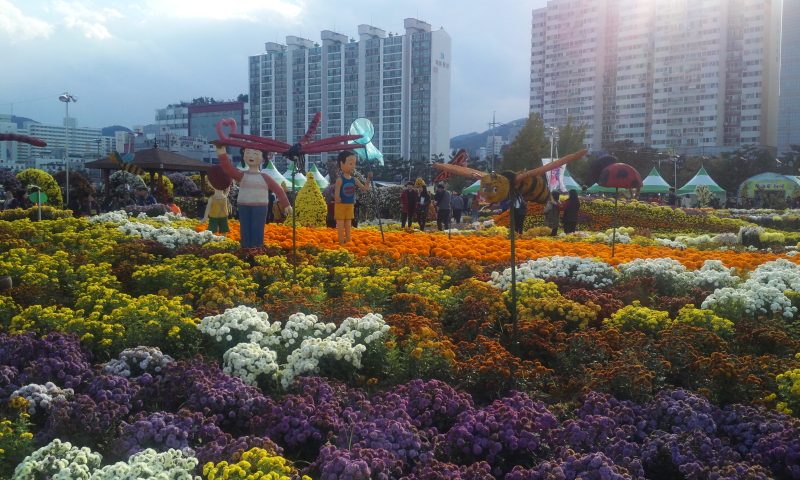Masan-si, located in the central-southern part of Gyeongsangnam-do province, is a city that has been incorporated into the integrated city of Changwon. It borders Changwon city to the east, Haman-gun and Goseong-gun to the west, Namhae to the south, and Haman-gun to the north. Situated at longitude 128°21 to 128°40 east and latitude 35°02 to 35°16 north, it covers an area of 330.57 square kilometers with a population of 410,078 (as of 2008). It consists of 1 eup (town), 4 myeon (townships), 27 dong (neighborhoods), and 184 ri (villages). The former city hall was located in Jungang-dong, Masan.
On March 2, 2010, a bill to integrate Masan-si, Jinhae-si, and Changwon-si into Changwon city was passed by the National Assembly, and on July 1 of the same year, the integrated city of Changwon was established. With the birth of the integrated city of Changwon, the northern region of the former Masan-si became Masanhoejang-gu, and the southern region became Masan-happo-gu. It is a city located in the center of the South Sea coast and is known for its beautiful natural attractions. During the winter, it is known as one of the best resort destinations in Korea due to its warm climate. If you climb to the top of Mt. Muhak, which embraces the city like a bird spreading its wings, you can see the calm Masan Bay, small and large harbors, and the city that unfolds along the coastline, creating a picturesque landscape.
Along the western slopes of Mt. Muhak, there is a historic site called Wollyeongdae, where Seonhak Choi Chi-won, a scholar of the Silla Dynasty, is said to have taught his disciples. 1 kilometer east of this place, there is a Mongjeong, where the Mongol and Goryeo allied forces watered their horses when they invaded Japan in the late 13th century. With good water quality, the area has developed early as a major producer of alcoholic beverages such as soju and soy sauce. The first export free zone in Korea, which is located on the eastern coast of the city center, is an industrial tourism attraction with more than 100 factories. In addition, there is Jododo Island, a small island in the middle of Masan Bay, which is called Dodseom (Stone Island) because it has no big trees and is covered with greenery only. A new large-scale comprehensive amusement park has been developed here, emerging as a unique marine tourist attraction in Korea. Furthermore, Gafowon Park in Gafodong is a popular destination for the citizens of Masan.
The Masan Arts Festival, held every October, is an event that aims to inherit and develop high-level cultural and artistic achievements through a festival led by artists. The Masan International Theater Festival, which started in 1989, aims to develop local culture through the internationalization of theater under the slogan Masan to the world, theater to the world. The festival takes place every May. In addition, there are other events such as Noksan Commemoration Festival held every October, and Daedongje, a festival dedicated to artists in Masan.
The Masan Municipal Museum, built as part of the commemorative project for the 100th anniversary of the opening of Masan Port, is located in Chusan-dong and consists of a permanent exhibition hall, a special exhibition hall, and an outdoor exhibition area. The Masan Music Hall, opened in 2005, aims to continue the artistic spirit of Masan musicians and contribute to the revitalization of local culture. The Moonshin Art Museum in Chusan-dong, opened in 1994 to celebrate 50 years of moonshin art, is a museum that exhibits works of Moonshin, a renowned artist, and was donated to Masan-si in 2003.
The Masan Comprehensive Sports Stadium, located in Yangdeok-dong, was completed in 1980 and includes a main stadium with a capacity of 21,474 spectators and an Olympic swimming pool. The Masan Workers Welfare Centers sports facilities, located within the center, were renovated in 2006 to improve the physical fitness and welfare of local workers.
Why visit Masan-si:
- Experience the natural beauty of Masan Bay and the surrounding coastline.
- Explore the historic sites of Wollyeongdae and Mongjeong.
- Enjoy the unique marine attractions of Jododo Island and the comprehensive amusement park.
- Immerse yourself in the rich cultural scene with events like the Masan Arts Festival and Masan International Theater Festival.
- Visit museums and art galleries, such as the Masan Municipal Museum and Moonshin Art Museum.
- Take part in various sports activities at the Masan Comprehensive Sports Stadium and Workers Welfare Center.
Plan your Visit:
- Best Time to Visit: Spring (April to June) and Autumn (September to November) offer pleasant weather for outdoor activities and sightseeing.
- Transportation: Masan-si can be reached by train or bus from major cities in South Korea. There is also an airport in nearby Gimhae for those arriving by air.
- Language: The official language is Korean, but some locals may have basic English language skills.
- Currency: The currency used in South Korea is the Korean Won (KRW).
- Safety: Masan-si is generally a safe city, but its always recommended to take normal safety precautions and be aware of your surroundings.


